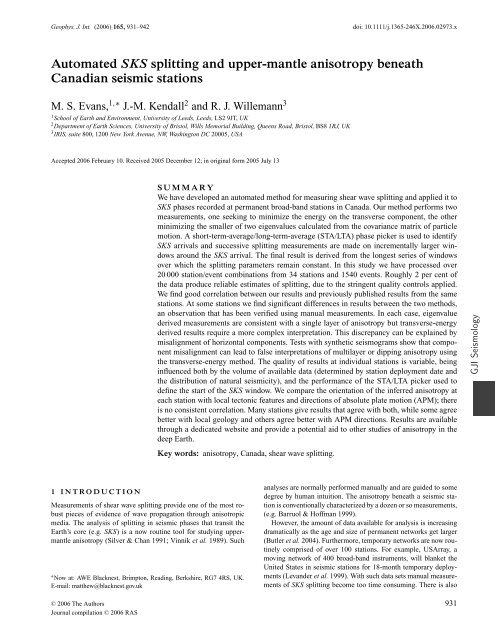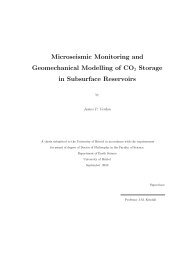Automated SKS splitting and upper-mantle anisotropy beneath ... - bris
Automated SKS splitting and upper-mantle anisotropy beneath ... - bris
Automated SKS splitting and upper-mantle anisotropy beneath ... - bris
Create successful ePaper yourself
Turn your PDF publications into a flip-book with our unique Google optimized e-Paper software.
940 M. S. Evans, J.-M. Kendall <strong>and</strong> R. J. WillemannFigure 8. Splitting parameters for eigenvalue <strong>and</strong> transverse energy measurements under the circumstance of horizontal component misalignment. Eachexample has one anisotropic layer with the parameters φ = 45 ◦ , δt = 1s. Components are misaligned by θ = −10, − 5, 0, 5 <strong>and</strong> 10 degrees, respectively,(positive = clockwise rotation). The eigenvalue method measurements (open circles) remain constant in each plot. Negative θ values lead to an increase in φby θ, except at the predicted null backazimuths (45 <strong>and</strong> 135 ◦ ). The δt value remains unaffected. Transverse energy method measurements are closed circles,<strong>and</strong> vary in both φ <strong>and</strong> δt, except for the case where θ = 0. Dashed lines show the true <strong>splitting</strong> values. Note the similarities between the top plots (θ = −10 ◦ )<strong>and</strong> Fig. 7.by comparing results with eigenvalue derived measurements <strong>and</strong>/orthe polarization of direct P arrivals.Splitting results from Canadian stations parallel tectonic structuresin the Northern Canadian Cordillera, the Innuitian orogeny<strong>and</strong> in the Appalachian orogeny. This is consistent with the hypothesisof vertically coherent deformation between the crust <strong>and</strong> <strong>mantle</strong>.At stations in central Canada, <strong>splitting</strong> measurements more closelyalign with APM directions than geological features, but correlationis less well defined. This could be because APM is an oversimplification,<strong>and</strong> more detailed 3-D <strong>mantle</strong> flow models may be required,(e.g. Fouch et al. 2000; Becker et al. 2003).Our results suggest that the dominant cause of <strong>anisotropy</strong> willdepend on the nature of the tectonic environment. Such conclusionsshould be more apparent as data from more stations are analysed,<strong>and</strong> future work involves automated analyses of <strong>SKS</strong> <strong>splitting</strong>at GSN stations worldwide. Splitting measurements generatedin this study are available through a web interface located athttp://www.isc.ac.uk/<strong>SKS</strong> <strong>and</strong> all source code used in this study areavailable via FTP at ftp://ftp.isc.ac.uk/pub/<strong>SKS</strong>.A C K N O W L E D G M E N T SMany thanks to K. Walker, J. Plomerova <strong>and</strong> T. Becker for theirdetailed comments <strong>and</strong> suggestions, which have greatly improvedthis manuscript. Research of this nature would not be possible withoutthe waveform data services offered by data centres to the wideracademic community. In this study we have extensively used theAutoDRM service of Earthquakes Canada <strong>and</strong> the NetDC serviceC○ 2006 The Authors, GJI, 165, 931–942Journal compilation C○ 2006 RAS
<strong>Automated</strong> <strong>SKS</strong> <strong>splitting</strong> 941Figure 9. The top plot shows polarization directions of corrected <strong>SKS</strong> phasesusing the eigenvalue method plotted against backazimuth at WALA. Thepredicted backazimuth is shown by the dashed line. There is a distinct biastowards larger polarization values consistent with anticlockwise misalignment,(mean offset 12 ◦ ). The bottom plot shows polarization directions ofdirect P arrivals measured at the same station, (mean offset 8 ◦ ).Figure 11. Splitting measurements in relation to APM <strong>and</strong> tectonics of theInnuitian orogeny. There is good correlation between <strong>splitting</strong> measurements<strong>and</strong> the trend of faults related to the Proterozoic Innuitian orogen (taken fromOkulitch (1991).Figure 12. Splitting measurements in relation to APM <strong>and</strong> tectonics of theAppalachian orogeny. Fault trends taken from Wheeler et al. (1996).Figure 10. Correlation between <strong>splitting</strong> measurements, tectonic features<strong>and</strong> APM directions for stations in Western Canada. T.T.: Tintina Trench.R.M.T. Rocky Mountain Trench G.S.L.S.Z.: Great Slave Lake Shear Zone.S.T.Z.: Snowbird Tectonic Zone. Orientation of geological features fromHoffman (1989); Wheeler et al. (1991, 1996). Arrows are estimates of currentday APM taken from DeMets et al. (1994), Kreemer et al. (2003) <strong>and</strong> Gripp& Gordon (2002). APM estimates for PGC are those of the subducting Ju<strong>and</strong>e Fuca plate, rather than the North American plate.of the IRIS Data Management Centre. We would also like to thankthe International Seismological Centre for providing Bulletin data<strong>and</strong> the continued use of their computing facilities, <strong>and</strong> the staff ofthe Czech Academy of Sciences for assistance with <strong>splitting</strong> codesin the early stages of this project.The IRIS DMS is funded through the National Science Foundation<strong>and</strong> specifically the GEO Directorate through the Instrumentation<strong>and</strong> Facilities Program of the National Science Foundationunder Cooperative Agreement EAR–0004370.Funding for this project was provided by NERC grant NER/A/S/2001/00524.C○ 2006 The Authors, GJI, 165, 931–942Journal compilation C○ 2006 RAS
942 M. S. Evans, J.-M. Kendall <strong>and</strong> R. J. WillemannR E F E R E N C E SAitken, J.D., 1993. Evolutionary models <strong>and</strong> tectonic comparisons; chapter13 in Sedimentary Cover of the Craton of Canada, pp. 799–808, eds Scott,D.F. & Aitken, J.D., Geological Survey of Canada, Geology of Canada no.5.Alsina, D. & Sneider, R.K., 1995. Small scale sublithospheric continentaldeformation: constraints from <strong>SKS</strong> <strong>splitting</strong> observations, Geophys. J.Int., 123, 431–448.Ando, M. & Ishikawa, Y., 1982. Observations of shear-wave polarisation<strong>anisotropy</strong> <strong>beneath</strong> Honshu, Japan: two masses with different polarizationsin the <strong>upper</strong> <strong>mantle</strong>, J. Phys. Earth, 30, 191–199.Barruol, G. & Hoffman, R., 1999. Upper <strong>mantle</strong> <strong>anisotropy</strong> <strong>beneath</strong> theGEOSCOPE stations, J. geophys Res., 104, 10 757–10 773.Becker, T.W., Kellogg, J.B., Ekstrom, G. & O’Connell, R.J., 2002. Comparisonof azimuthal seismic <strong>anisotropy</strong> from surface waves <strong>and</strong> finite strainfrom global <strong>mantle</strong>-circulation models, Geophys. J. Int., 155, 696–714.Bostock, M.G. & Cassidy, J.F., 1995. Variations in <strong>SKS</strong> <strong>splitting</strong> acrosswestern Canada, Geophys. Res. Lett., 22, 5–8.Butler, R. et al., 2004. The global seismograph network surpasses its designgoal, EOS, Trans. Am. geophys. Un., 85, 225–229.Chevrot, S., 2000. Multichannel analysis of shear wave <strong>splitting</strong>, J. geophysRes., 105, 21 579–21 590.Currie, C.A., Cassidy, J.F., Hyndman, R.D. & Bostock, M.G., 2004. Shearwave <strong>anisotropy</strong> <strong>beneath</strong> the Cascadia subduction zone <strong>and</strong> western NorthAmerica craton, Geophys. J. Int., 157, 341–353.DeMets, C., Gordon, R.G., Argus, D.F. & Stein, S., 1994. Effect of recentrevisions to the geomagnetic reversal time scale on estimates of currentplate motions, Geophys. Res. Lett., 21, 2191–2194.Douglas, R.J.W., 1973. Geological Provinces, The National Atlas of Canada,Geological Survey of Canada.Earle, P.S. & Shearer, P.M., 1994. Characterization of global seismogramsusing an automatic picking algorithm, Bull. seism. Soc. Am., 84, 366–376.Earthquakes Canada, 2003. GSC Continuous Waveform Archive,AutoDRM@seismo.NRCan.gc.ca, Nat. Res. Can, see: http://earthquakescanada.nrcan.gc.ca/cite e.php.Fouch, M.J., Fischer, K.M., Parmentier, E.M., Wysession, M.E. & Clarke,T.J., 2000. Shear wave <strong>splitting</strong>, continental keels <strong>and</strong> patterns of <strong>mantle</strong>flow, J. geophys. Res., 105, 6255–6276.Gripp, A.E. & Gordon, R.G., 2002. Young tracks of hotspots <strong>and</strong> currentplate velocities, Geophys. J. Int., 150, 321–361.Hellfrich, G., Silver, P. & Given, H., 1994. Shear-wave <strong>splitting</strong> variationsover short spatial scales on continents, Geophys. J. Int., 119, 561–573.Hoffman, P.F., 1989. Precambrian geology <strong>and</strong> tectonic history of NorthAmerica in The geology of North America—an overvew, eds Bally, A.W.& Palmer, A.R., Geological Society of North America.International Seismological Centre, 2003. On-line Bulletin,http://www.isc.ac.uk/Bull, Internatl. Seis. Cent., Thatcham, UK.Kennett, B.L.N. & Engdahl, E.R., 1991. Traveltimes for global earthquakelocation <strong>and</strong> phase identification, Geophys. J. Int., 105, 429–465.Kreemer, C., Holt, W.E. & Haines, A.J., 2003. An integrated global modelof present day plate motions <strong>and</strong> plate boundary deformation, Geophys.J. Int., 154, 8–34.Lev<strong>and</strong>er, A., Humpreys, G., Ekstrom, G., Meltzer, A. & Shearer, P., 1999.USArray: An earth sciences initiative to investigate the North Americancontinent EOS Trans AGU., 80, 245.Levin, V., Menke, W. & Park, J., 1999. Shear wave <strong>splitting</strong> in the Appalachians<strong>and</strong> the Urals: A case for multilayered <strong>anisotropy</strong>, J. geophys. Res.,104, 17 975–17 993.Okulitch, A.V., 1991. Geology of the Canadian archipelago <strong>and</strong> north Greenl<strong>and</strong>;Figure 2 in Innuitian orogen <strong>and</strong> Arctic platform: Canada <strong>and</strong> Greenl<strong>and</strong>,ed. Trettin, H.P., Geological Survey of Canada.Plomerova, J., Sileny, J. & Babuska, V., 1996. Joint interpretation of <strong>upper</strong><strong>mantle</strong>anistropy based on teleseismic P-travel time delays <strong>and</strong> inversionof shear-wave <strong>splitting</strong> parameters, Phys. Earth planet. Int., 95, 293–309.S<strong>and</strong>vol, E. & Hearn, T., 1994. Bootstrapping shear-wave <strong>splitting</strong> errors,Bull. seism. Soc. Am., 84, 1971–1977.Savage, M.K. & Silver, P.G., 1993. Mantle deformation <strong>and</strong> tectonics: constraintsfrom seismic <strong>anisotropy</strong> in Western United States, Phys. Earthplanet. Int., 78, 207–227.Sileny, J. & Plomerova, J., 1996. Inversion of shear-wave <strong>splitting</strong> parametersto retrieve three-dimensional orientation of <strong>anisotropy</strong> in continentallithosphere, Phys. Earth planet. Int., 95, 277–292.Silver, P.G., 1996. Seismic <strong>anisotropy</strong> <strong>beneath</strong> the continents: Probing thedepths of geology, Annu. Rev. Earth Pl. Sc., 24, 385–432.Silver, P.G. & Chan, W.W.J., 1991. Shear-wave <strong>splitting</strong> <strong>and</strong> subcontinental<strong>mantle</strong> deformation, J. geophys. Res., 96, 16 429–16 454.Silver, P.G. & Savage, M.K., 1994. The interpretation of shear-wave <strong>splitting</strong>parameters in the presence of two anisotropic layers, Geophys. J. Int., 119,949–963.Vinnik, L.P., Kosarev, G.L. & Makeyeva, L.I., 1984. Anisotropy of the lithosphereaccording to the observations of <strong>SKS</strong> <strong>and</strong> SKKS waves, Dokl.Akad. Nauk. SSSR., 278, 1335.Vinnik, L.P., Farra, V. & Romanowicz, B., 1989. Azimuthal <strong>anisotropy</strong> inthe earth from observations of <strong>SKS</strong> at GEOSCOPE <strong>and</strong> NARS broadb<strong>and</strong>stations, Bull. seis. Soc. Am., 79, 1542–1558.Wheeler, J.O., Brookfield, A.J., Gabrielse, H., Monger, J.W.H., Tipper, H.W.& Woodsworth, G.J., 1991. Terrane map of the Canadian Cordillera, GeologicalSurvey of Canada., Map 1713A.Wheeler, J.O., Hoffman, P.F., Card, K.D., Davidson, A., Sanford, B.V.,Okulitch, A.V. & Roest, W.R., 1996. Geological Map of Canada, GeologicalSurvey of Canada., Map 1860A.Wookey, J., Kendall, J.-M. & Rumpker, G., 2005. Lowermost <strong>mantle</strong><strong>anisotropy</strong> <strong>beneath</strong> the north Pacific from differential S-ScS <strong>splitting</strong>,Geophys. J. Int. 161, 829–838.C○ 2006 The Authors, GJI, 165, 931–942Journal compilation C○ 2006 RAS











